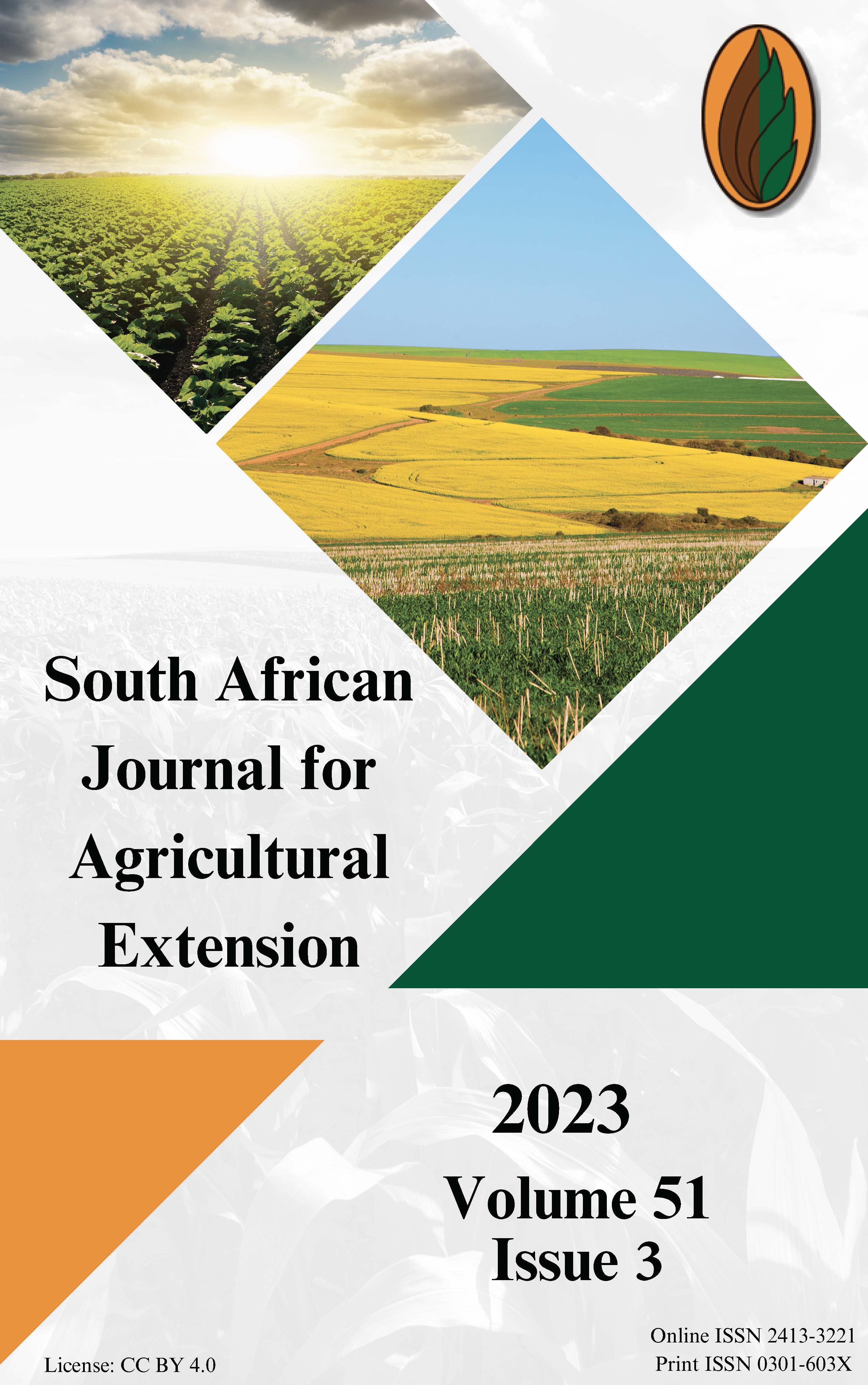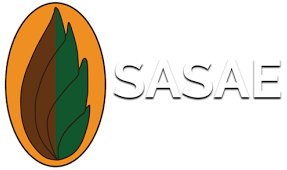Measuring Women’s Empowerment in Agriculture in the Gauteng Province of South Africa
DOI:
https://doi.org/10.17159/2413-3221/2023/v51n3a15857Keywords:
Women empowerment, Sustainable Agriculture, Gender Equality, Commercial EconomyAbstract
Commercial restrictions limit the extent of women's participation in the South African economy despite gender equality being valued. Since the implementation of The Women Empowerment Project in 1999, the agricultural sector's contribution has not yet been fully quantified. Women’s opportunities, challenges, and roles in agriculture must be explored further by evaluating resource management strategies and policies. This study aimed to quantify women's empowerment in agriculture using descriptive research methodology. Data were collected and statistically analysed using the Women’s Empowerment in Agriculture Index (WEAI) to identify the origin and extent of female farmers' difficulties. Satisfactory outcomes in production, leadership, assets, income, and time usage were more strongly associated with empowerment than demographic variables, and time available contributed the most to women feeling disempowered. Overall, women reported feeling more empowered compared to men. Disempowerment in male respondents as the control group was attributed to time, workload, and resources. In future studies, gender policies should be further developed to incorporate gender dimension, gender budgeting and sex-disaggregated data administration.
Downloads
References
AKTER, S., RUTSAERT, P., LUIS, J., HTWE, N.W., SAN, S., RAHARJO, B. & PUSTIKA, A., 2015. Women’s empowerment and gender equity in agriculture: A different perspective from Southeast Asia. Food Policy., 69: 270-279. DOI: https://doi.org/10.1016/j.foodpol.2017.05.003
ALKIRE, S., MEINZEN-DICK, R., PETERMAN, A., QUISUMBING, A.R., SEYMOUR, G. & VAZ, A., 2013. The Women’s Empowerment in Agriculture Index, OPHI working paper No. 58. University of Oxford. Available from https://www.ophi.org.uk/wp-content/uploads/ophi-wp-58.pdf DOI: https://doi.org/10.35648/20.500.12413/11781/ii033
BUDOO, A., 2016. Gender budgeting as a means to implement the Maputo protocol’s obligations to provide budgetary resources to realise women’s human rights in Africa. Afr. J. Leg. Stud., 9: 199-219. DOI: https://doi.org/10.1163/17087384-12340008
CRESSWELL, J.W., 2009. Research design: Qualitative, quantitative, and mixed methods approaches. 3rd ed. Thousand Oaks, California: Sage Publications.
DEPARTMENT OF AGRICULTURE, FORESTRY, AND FISHERIES (DAFF)., 2012. Integrated Growth and Development Plan (IGDP). Pretoria, South Africa: Department of Agriculture, Forestry, and Fisheries. Available from https://www.gov.za/sites/default/files/gcis_document/201409/daffigdp2012.pdf. (27 August 2017.
DEPARTMENT OF AGRICULTURE, FORESTRY AND FISHERIES (DAFF)., 2016. Guide: DAFF Female Entrepreneur Awards 2019/20 - 2020/2021. Pretoria, South Africa: DAFF. Available from https://www.gov.za/sites/default/files/gcis_document/201610/daff-annual-report-2015-2016a.pdf
DEPARTMENT OF AGRICULTURE, FORESTRY AND FISHERIES (DAFF)., 2018. National Policy on Comprehensive Producer Development Support, Government Gazette Notice 429. Pretoria, South Africa: DAFF. Available from https://www.dalrrd.gov.za/docs/media/Notice%20to%20gazette%20the%20policy%20(2).pdf
DEPARTMENT OF RURAL DEVELOPMENT AND LAND REFORM (DRDLR)., 2017. Land Audit Report. Phase II: Private land ownership by race, gender, and nationality. Pretoria, South Africa: Department of Rural Development and Land Reform. Available from https://www.gov.za/documents/land-audit-report-2017-5-feb-2018-0000
DEPARTMENT OF WOMEN (DOW)., 2013. Doing more with less: A South African gender budget analysis for health. Pretoria, South Africa: Department of Women. Available from http://www.women.gov.za/attachments/article/14/GRB%202013%20Report%20(Final).pdf
FOOD AND AGRICULTURE ORGANISATION (FAO)., 2017. Leaving no one behind: Achieving gender equality for food security, nutrition and sustainable agriculture. Rome: FAO. Available from https://www.fao.org/indigenous-peoples/detail/en/c/902834/
FOOD AND AGRICULTURAL ORGANISATION (FAO)., 2023. The Status of Women in Agrifood Systems. Rome: FAO. Available from https://doi.org/10.4060/cc5343en DOI: https://doi.org/10.4060/cc5343en
HAUG, R., MWASEBA, D.L., NJARUI, D., MOELETSI, M., MAGALASI, M., MUTIMURA, M., HUNDESSA, F. & AAMODT, J.T., 2021. Feminisation of African agriculture and the meaning of decision-making for empowerment and sustainability. Sustainability., 13(16): 8993. DOI: https://doi.org/10.3390/su13168993
INMAN, R.P. & RUBINFELD, D.L., 2013. Understanding the democratic transition in South Africa. Am. Law Econ. Rev., 15(1): 1-38. DOI: https://doi.org/10.1093/aler/ahs023
JOSEPH, C., 2017. Sustainable Development and the Index of Women’s Empowerment in Agriculture. Women’s Empowerment WEAI SDG’s MDG’s. Friedman School of Nutrition Science and Policy, Tufts University.
KOEHLER, G., 2016. Tapping the SDGs for Progressive Gender Equity and Equality Policy? Gender and Development., 24(1): 53-68. DOI: https://doi.org/10.1080/13552074.2016.1142217
LEVENDALE, C., 2017. Towards women’s economic empowerment: An overview of challenges, achievements, legislative mechanisms and programmes. Cape Town, South Africa: Parliament of Republic of South Africa. Available from https://www.parliament.gov.za/storage/app/media/uploaded-files/International%20Womens%20Conference%202017%20-%20Womens%20Economic%20Empowerment%20-%20August%202017.pdf.
MALHOTRA, A. & SCHULER, S.R., 2005. Measuring women’s empowerment as a variable in international development. In Background Paper Prepared for the World Bank Workshop on Poverty and Gender: New Perspectives. Washington, DC: The World Bank.
MAYRA, B. & FURST-NICHOLS, R., 2014. Promoting women’s economic empowerment: What works? Policy Research Working Paper No. 7087. Washington, DC: World Bank Group.
MEINZEN-DICK, R., 2019. Empowering Africa’s Women Farmers. Project Syndicate. Available from https://www.project-syndicate.org/commentary/women-farmers-africa-gender-equality-agriculture-by-ruth-meinzen-dick-2019-10
MORNA, C.L. & NYAKUJARAH, L.J., 2011. SADC Gender Protocol Barometer: Introducing the SADC gender and development index. Johannesburg, South Africa: Southern Africa Gender Protocol Alliance. Available from https://genderlinks.org.za/programme-web-menu/publications/sadc-gender-protocol-2011-barometer-2011-08-05/
MUTENJE, M., KANKWAMBA, H., MANGISONI, J. & KASSIE, M., 2016. Agricultural innovations and food security in Malawi: Gender dynamics, institutions and market implications. Technol. Forecast. Soc. Change., 103: 240–248. DOI: https://doi.org/10.1016/j.techfore.2015.10.004
NDIRITU, S.W., KASSIE, M. & SHIFERAW, B., 2014. Are there systematic gender differences in the adoption of sustainable agricultural intensification practices? Evidence from Kenya. Food Policy., 49(1): 117–127. DOI: https://doi.org/10.1016/j.foodpol.2014.06.010
NJUKI, J. & SANGINGA, P.C., 2013. Women, livestock ownership and markets: Bridging the gender gap in Eastern and Southern Africa. New York: Routledge. DOI: https://doi.org/10.4324/9780203083604
OGATO, G.S., BOON, E. & SUBRAMANI, J., 2009. Gender roles in crop production and management practices: A case study of three rural communities in Ambo District, Ethiopia. Econ J Hum Ecol., 27(1): 1-20. DOI: https://doi.org/10.1080/09709274.2009.11906186
ORGANISATION FOR ECONOMIC CO-OPERATION AND DEVELOPMENT (OECD)., 2021. Gender and the environment: Building evidence and policies to achieve the SDGs. Paris: OECD Publishing.
OXFAM., 2019. Feminist Aid: A call for G7 leaders to beat inequality. Oxfam, Oxford. Available from https://www.oxfam.org/en/research/feminist-aid-call-g7-leaders-beat-inequality.
PEACE, T.R., 2014. Unleashing Women’s Potential: Investing in Women in Agriculture at the Center of Africa Transforming and Rising [Keynote address]. Fourth Africa Green Revolution Forum (AGRAF), African Union Conference Center, Nelson Mandela Hall, Addis Ababa, Ethiopia.
SANTRA, S.K. & KUNDU, R., 2001. Women’s empowerment for sustainable agriculture. Manage. Ext. Res. Rev., 11: 131- 190.
SHARAUNGA, S., MUDHARA, M. & BOGALE, A., 2019. Conceptualisation and measurement of women’s empowerment revisited. J. Hum. Dev. Capab., 20(1): 1-25. DOI: https://doi.org/10.1080/19452829.2018.1546280
SHARP, J., BRIGGS, J., YACOUB, H. & HAMED, N., 2003. Doing gender and development: Understanding empowerment and local gender relations. Trans. Inst. Br. Geo., 28(3): 281-295. DOI: https://doi.org/10.1111/1475-5661.00093
SHIFERAW, B., KEBEDE, T., KASSIE, M. & FISHER, M., 2015. Market imperfections, access to information and technology adoption in Uganda: Challenges of overcoming multiple constraints. Agric. Econ., 46(4): 475–488. DOI: https://doi.org/10.1111/agec.12175
SRABONI, E., MALAPIT, H.J., QUISUMBING, A.R. & AHMED, A.U., 2014. Women’s empowerment in agriculture: What role for food security in Bangladesh? World Develop., 61: 11-52. DOI: https://doi.org/10.1016/j.worlddev.2014.03.025
STATISTICS SOUTH AFRICA (STATS SA)., 2017. Census of commercial agriculture, 2017: Financial and production statistics. Pretoria, South Africa: Stats SA. Available from https://www.statssa.gov.za/publications/Report-11-02-01/Report-11-02-012017.pdf
TOWNSEND, J., ZAPATA, E., ROWLANDS, J., ALBERTI, P. & MERCADO, M., 1999. Women and power: fighting patriarchies and poverty. London: Zed Books.
UKEJE, I.O., OGBULU, U., IDIKE, A.N., NDUKWE, C., IWUALA, H. & CLEMENTINA, K., 2020. Policy-making for sustainable empowerment and poverty reduction scheme in Nigeria. In A. Farazmand (ed.), Global encyclopaedia of public administration, public policy, and governance. Cham: Springer. DOI: https://doi.org/10.1007/978-3-319-31816-5_3922-1
WORLD BANK., 2012. World development report: Gender equality and development. Washington: World Bank. Available from https://openknowledge.worldbank.org/handle/10986/4391
WORLD BANK., 2023. Gender Strategy 2024-2030: Accelerate Gender Equality for a Sustainable, Resilient, and inclusive Future – Consultation Draft. Washington: World Bank. Available from https://documents.worldbank.org/en/publication/documents-reports/documentdetail/099013107142345483/secbos04cf7b650208a5e08b784c0db6a4
WORLD ECONOMIC FORUM (WEF)., 2022. The Global Gender Gap Report 2023. World Economic Forum. Available from https://www.weforum.org/reports/global-gender-gap-report-2023/
WRIGHT, W. & ANNES, A., 2017. Farm women and the empowerment potential in value-added agriculture. Rur. Soc., 81(4): 545-571. DOI: https://doi.org/10.1111/ruso.12105
Downloads
Published
Issue
Section
License
Copyright (c) 2023 K. Thobejane, J.W. Swanepoel, J.A. Van Niekerk, H. Van der Merwe

This work is licensed under a Creative Commons Attribution 4.0 International License.








.png)